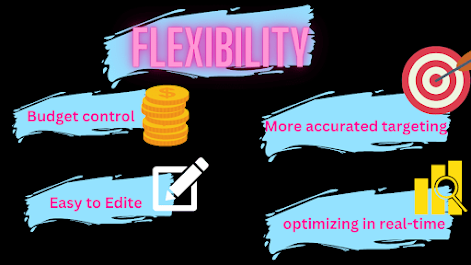The Top 6 Benefits of Search Engine Marketing for Your Business
Search engine marketing (SEM) is a digital marketing strategy that involves promoting a website through paid advertising on search engines, such as Google, Bing, and Yahoo. SEM can be an effective way to reach potential customers and drive traffic to a website.
Here are the top 6 advantages of SEM:
1-High visibility: SEM campaigns can help a website rank higher in search engine results pages (SERPs), which can increase the chances of being seen by potential customers.
When a user searches for something on a search engine like Google, the search engine returns a list of results known as the search engine results page (SERP). The higher a website ranks on the SERP, the more visible it is to users. SEM campaigns can help a website rank higher on the SERP by bidding on specific keywords and phrases that users are searching for. When a user searches for one of these keywords, the website's ad will appear at the top or side of the SERP, increasing its visibility to users.
Having a high visibility on the SERP can be especially important for businesses because it can help increase the chances that a user will click on their website. Studies have shown that users are more likely to click on a website that appears at the top of the SERP than one that appears lower down. This is because users tend to assume that websites that rank higher are more relevant and trustworthy.
By using SEM to increase a website's visibility on the SERP, businesses can attract more qualified traffic to their website, which can lead to more leads and sales.
2-Targeted audience: SEM allows advertisers to target specific keywords, demographics, and geographic locations, which can help ensure that ads are being seen by the right people.
SEM campaigns allow advertisers to target specific keywords, demographics, and geographic locations when placing their ads. This means that advertisers can tailor their ads to reach specific groups of people who are most likely to be interested in their products or services.
For example, if a business sells outdoor gear and clothing, they might use SEM to target users who are searching for keywords related to camping, hiking, and other outdoor activities. They could also target users in specific geographic locations, such as users in a particular city or region.
Demographic targeting allows advertisers to reach users based on factors such as age, gender, and interests. For example, a business that sells baby products might use demographic targeting to reach parents with young children.
By targeting specific keywords, demographics, and geographic locations, advertisers can ensure that their ads are being seen by the right people and are more likely to be effective. This can help businesses get the most out of their SEM campaigns and maximize their return on investment.
3-Measurable results: SEM campaigns can be tracked and measured using tools such as Google Analytics, making it easy to see how effective they are and make adjustments as needed.
One of the major advantages of SEM is that it provides measurable results. Advertisers can use tools such as Google Analytics to track and measure the performance of their SEM campaigns. This allows them to see how effective their campaigns are and make adjustments as needed to optimize their results.
Google Analytics is a free web analytics service that provides a wealth of information about a website's traffic and performance. It allows advertisers to see how many people are clicking on their ads, where they are coming from, and what actions they are taking on the website.
By tracking and measuring the results of their SEM campaigns, advertisers can see which keywords, ad groups, and targeting options are performing the best and adjust their campaigns accordingly. This can help them get the most out of their advertising budget and improve the ROI of their campaigns.
In addition to tracking and measuring the results of their campaigns, advertisers can also use tools such as Google Analytics to track the performance of their website and identify any issues that might be impacting its performance. This can help them make improvements to their website and improve the user experience for their visitors.
4-Quick results: Unlike some other marketing strategies, SEM can provide almost immediate results. As soon as an ad campaign is launched, it can start generating traffic and leads.
SEM provides immediate results. As soon as an ad campaign is launched, it can start generating traffic and leads for a business. This is because SEM ads are targeted at users who are actively searching for the products or services that a business offers.
For example, if a business launches an SEM campaign targeting users who are searching for "outdoor gear," their ads will appear on the SERP when users search for those keywords. This can help the business reach potential customers who are already interested in their products and are more likely to make a purchase.
In contrast, other marketing strategies, such as contentmarketing or social media marketing, can take longer to generate results. These strategies often involve creating and promoting content or engaging with users over time to build a following. While these strategies can be effective, they typically require a longer time frame to see results.
By providing quick results, SEM can be an effective way for businesses to drive traffic and generate leads in the short term. It can be especially useful for businesses that need to generate immediate results, such as those launching a new product or service.
5-Cost-effective: Advertisers can set a budget for their SEM campaigns and only pay when someone clicks on their ad, making it a cost-effective way to reach a targeted audience.
SEM can be a cost-effective way for businesses to reach a targeted audience because advertisers only pay when someone clicks on their ad. This is known as pay-per-click (PPC) advertising.
With PPC advertising, advertisers set a budget for their campaigns and bid on specific keywords that they want their ads to appear for. When a user searches for one of those keywords, the advertiser's ad will appear on the SERP, and the advertiser will pay a fee each time the ad is clicked. The fee is determined by the bid amount and the quality score of the ad.
Because advertisers only pay when someone clicks on their ad, they can control their budget and only pay for the traffic they receive. This makes SEM a cost-effective way to reach a targeted audience because the business only pays when it gets results.
In addition to being cost-effective, SEM also provides a good return on investment (ROI) for many businesses. By targeting specific keywords and demographics, businesses can reach qualified users who are more likely to make a purchase, which can help maximize the ROI of their campaigns.
6-Flexibility: Advertisers have a lot of control over their SEM campaigns, including the ability to adjust their budget, targeting, and ad creative on the fly. This allows them to make changes and optimize their campaigns in real-time to get the best results.
SEM campaigns offer a high level of flexibility, allowing advertisers to make changes and optimize their campaigns in real-time to get the best results.
One-way advertisers can exercise this flexibility is by adjusting their budget. Advertisers can set a budget for their campaigns and change it as needed to meet their goals. For example, if a campaign is performing well and generating a lot of leads, the advertiser might increase their budget to get even more traffic and leads. On the other hand, if a campaign is not performing as well as expected, the advertiser can decrease their budget to reduce their costs.
Advertisers also have a lot of control over the targeting of their campaigns. They can adjust the keywords, demographics, and geographic locations that their ads are targeting to reach the right audience. This allows them to fine-tune their targeting to get the best results.
In addition to adjusting their budget and targeting, advertisers can also make changes to the ad creative, such as the headlines and descriptions of their ads. This allows them to test different versions of their ads and see which ones perform the best.
Overall, the flexibility of SEM campaigns allows advertisers to make changes and optimize their campaigns in real-time to get the best results. This can help businesses get the most out of their advertising budget and maximize their return on investment.

,%20which%20can%20increase%20the%20chances%20of%20being%20seen%20by%20potential%20customers..png)





